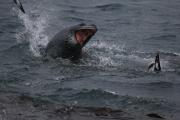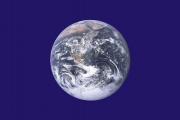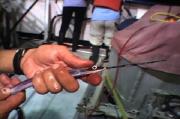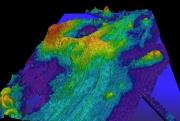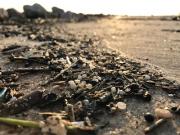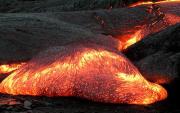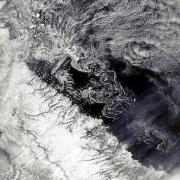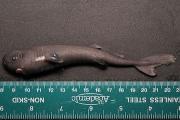Radio Program
Our regular Science and the SeaTM radio program presents marine science topics in an engaging two-minute story format. Our script writers gather ideas for the radio program from the University of Texas Marine Science Institute's researchers and from our very popular college class, Introduction to Oceanography, which we teach to hundreds of non-science majors at The University of Texas at Austin every year. Our radio programs are distributed at to commercial and public radio stations across the country.
Leopard seals are dangerous loners. They can be 10 feet long and weigh half a ton, and they sometimes attack people -- they’ve killed at least one.
Yet they’ve also been known to offer penguins to divers. Some have seen the gesture as a friendly gift, or perhaps as an act of pity for a poor hunter. But British researchers recently came up with another possible explanation: The seal might be trying to get the diver to share a meal -- an act that would make it easier for the seal to consume its dinner.
By the late 1960s, many Americans were getting fed up with bad news about the environment. A book early in the decade warned about the dangers of pesticides. An oil spill on the coast of California killed thousands of birds and other creatures. A river in Ohio caught fire. And pictures snapped by Apollo astronauts showed Earth as a fragile blue ball.
To inform Americans about the problems, Senator Gaylord Nelson of Wisconsin organized an “environmental sit-in.” It was held on April 22nd of 1970 -- the first Earth Day. And an estimated 20 million people took part.
A fish known as the halfbeak looks like it’s about ready to do some knitting, have a sword fight, or give somebody an injection. That’s because its lower jaw resembles a needle -- it’s long, thin, and pointed. But the halfbeak doesn’t appear to use it to “jab” anything at all.
There are about 70 species of halfbeaks. They’re found in the open ocean or in coastal waters around the world. Most are no more than a few inches long, with sleek silvery bodies. They live near the surface, so they’re darker on top than the bottom -- a bit of camouflage from both predators and prey.
The busiest volcano in the Pacific Northwest isn’t Mount Rainier, Mount Hood, or even Mount St. Helens. Instead, it’s a peak that’s 300 miles off the Oregon coast, almost a mile beneath the surface of the Pacific Ocean.
Axial Seamount belongs to a chain of submarine volcanoes that stretches from Oregon to near Alaska. They’ve built up along the boundaries between slabs of Earth’s crust. Axial, for example, is on the fault between the Juan de Fuca Plate and the Pacific Plate. Magma pushes up along the boundary, building underwater volcanoes.
A “nurdle” sounds like a character from a children’s TV show. And if you look at one, it seems just about as harmless. But these tiny plastic beads can cause big problems for marine life.
“Nurdle” is a nickname for plastic pellets that are no more than five millimeters across -- the thickness of a stack of three U.S. quarters. The pellets are the raw materials for making larger plastic items, from toothbrushes to cellphone cases to car parts.
When a volcano began erupting on the island of Hawaii in May of 2018, satellites kept a close eye on it. Just three days after the lava flow hit the ocean, for example, they saw that the water was turning green. And it stayed green until after the eruption ended a few months later.
The Kilauea volcano belched millions of cubic feet of rock. The flow destroyed about 700 houses and covered more than 10 square miles on the island’s eastern tip.
Hundreds of submarines glide through the world’s oceans. Most of them are military, but some sail for science. They measure temperatures and currents, sample the water, map the sea floor, and perform other tasks -- revealing the secrets of the oceans.
There’s an old saying that if life gives you lemons, make lemonade. Some folks in northeastern Canada are following that advice -- with a twist. When life gives them icebergs, they’re making vodka -- and selling excursions to the bergs to eager tourists.
The businesses are taking off along “iceberg alley.” That’s a stretch of ocean from Greenland to Labrador and Newfoundland. Big chunks of ice break off glaciers in Greenland and follow the current down to Canada.
Biologists have been sampling life in the Gulf of Mexico for decades. Yet they're a long way from getting acquainted with everything that lives there.
Consider a tiny shark that was discovered there a decade ago. When researchers pulled it from the water, they didn't recognize it. It took them until 2019 to classify it. It turns out the shark is a member of a species never seen before.
A massive tsunami in northwestern Sumatra wiped out coastal villages for miles. Only one survived. But by a century later, its influence began to wane -- the result of a new power settling on the sites of the destroyed villages.
Archaeologists began studying the area in detail after another tsunami, in 2004, killed more than 150,000 in Sumatra alone. And in 2006, one researcher discovered bits of pottery and Muslim gravestones that were uncovered by the 2004 tsunami. He recruited a large team to study a 25-mile stretch of coastline in a region known as Aceh.

